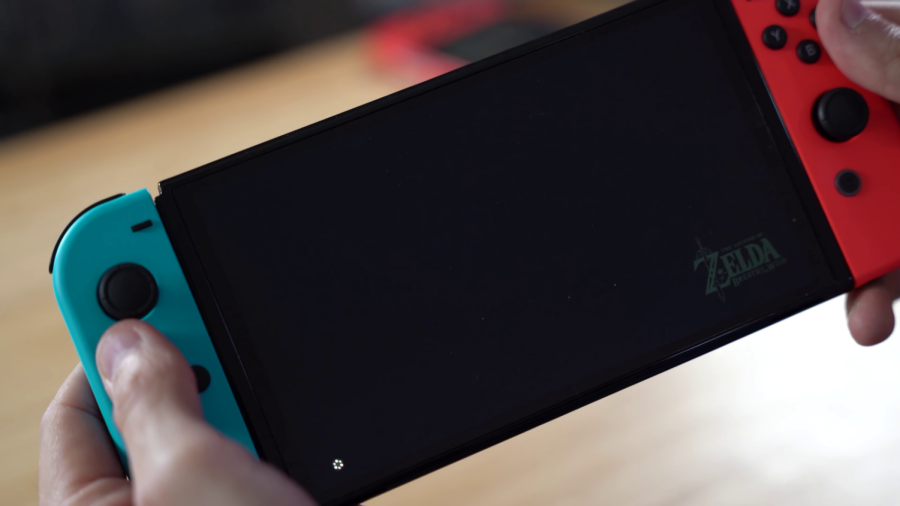Metroid: “Other M” is a vast departure from the Metroid franchise in that it’s a game that’s constantly telling you what to do – both in the story and the gameplay.
In itself, “Other M” is a great game that’s fun to play with fresh gameplay that’s got a lot of ticks. At the same time, “Other M” is not a great Metroid game in the way that other Metroids are great. It feels like Metroid, but it looks and plays like a mix between God of War and Metal Gear Solid. In space.
Playing the game is a lot like ordering a bacon cheeseburger with fries and a shake and then getting a burger with a fried egg on it with sweet potato fries and a protein shake. Yeah it was good, but what the hell was that about?
Fans familiar with the earlier Metroid Fusion installment will recognize the game’s more linear structure in place of the trademark non-linear, isolated wandering that is featured in most Metroid games.
The most glaring differences between “Other M” and the other Metroids is developer Team Ninja’s move from the first-person shooter camera used in the recent “Metroid Prime” games to a third-person camera view. It’s the same camera-view that’s used in the “Metroid Prime” games when the player goes into the morph ball or uses the space jump, so it’s not a completely new perspective for experienced players.
What does take a lot of getting used to is the fact that, in “Other M,” the player is taking orders.
The game’s premise, which starts with perpetual Metroid protagonist Aran responding to a distress call at a space station, takes a new turn when the bounty hunter joins up with a squad of Galactic Federation troops to investigate the station. Of course, like any space station Aran has ever visited, something has gone horribly wrong and it will likely end up in an explosion. In the squad is her friendly former comrade, Anthony, and a rough, brooding commanding officer, Adam. Aran is revealed to have spent a period of time in the Galactic Federation Army.
What this does is include something that has been virtually absent from the entire Metroid franchise: dialogue. Aran is forced to interact with the troops and is soon under the temporary command of Adam, who continually orders her around as the background story of the station unfolds, similar to how Solid Snake gets briefed in Metal Gear Solid. It’s weird.
The Metroid franchise is a case study in isolation and minimalism. There’s no text, no dialogue, just actions. Fusion introduced this a bit, but “Other M” brings it to another level. While previous games have showcased the intense isolation that the franchise’s heroine goes through as she slowly wipes out an entire planet, “Other M” is the first game to show the inner emotions and insecurities of the character.
The gameplay is, for the most part, fun and new. Combat is like playing God of War with a blaster arm, which means all the player has to do is fire in the general vicinity of an enemy and Aran will do the rest. Another colorful edition is Aran’s ability to dodge, duck, dip, dive and dodge quickly, instead of her usual ability to take long, floaty jumps. An extension of this is the option to now jump on enemies to take a point-blank shot to shoot the enemy’s face-off like in “Face-off.”
As in some Metroid games, Aran begins the game without her full repertoire of abilities, which are usually taken away by an over-the-top crash or injury. But in “Other M,” Aran is not allowed to use most of her powers until she is told she can due to the dangers of things like power bombs. This logic, however, is lost when it’s apparent that Aran is not allowed to use her better armor, grappling shot or slightly stronger beams for an arbitrary reason. The most frustrating realization comes when Aran, no longer getting orders, decides to start using the space jump (continuous jump) and screw attack abilities, which now allow her to kill enemies that were once bosses in one hit, by jumping into them.
Like Fusion, the game takes place on a large space station, but it’s quickly apparent that the game’s horizons were not to be limited by such constraints. The facility is so large, with elaborate, world-like environments that make the player forget that it is a space station.
This in itself involves a little suspension of disbelief. The programmers probably didn’t think the player would wonder who in the world created the vast, endless lava cavern with the enormous lava-sharktopus that jumps out of the lava like a coked-out whale. Seriously, who spent 15 years and 19 gajillion space dollars to build the endless lava cavern? What scientific value could that have?
The station is rife with minibosses, most of whom are entertaining and challenging, though repeat fights get old fast. The most annoying part of the bosses is that, for some reason, one attack will damage the enemy for a while and then stops without any major indication, leaving the player guessing why shooting it no longer does anything. It’s one thing to have flashing weak points, but it’s another to not give a hint.
However, easily the most negative aspect of the game is the incorporation of missiles. In “Other M,” the player can go into first-person mode at any point by simply pointing the wii-mote at the screen. Through this, the player can now lock on to enemies to fire missiles. At first glance it’s a cool feature, but in battle the feature is slow and frustrating, especially during boss fights.
It seems easy to just point and shoot, but instead of there being a “fire missile” button, the player must aim the wii-mote at the screen, wait for the camera to shift, point the wii-mote at the enemy, lock on and then fire, all while standing completely still.
However, the game acknowledges the clunks present in its missiles, requiring them to be used on a vulnerable, stationary target, or rewarding the player for taking a risk with one mid-combat. But when certain battles call for a quick missile hit, the process can be a struggle.
Speaking of missiles, they’re unlimited in “Other M.” Rather than picking them up from defeated enemies, Aran can now recharge her supply of them by standing still for a moment, pointing the wii-mote up and holding “A.” This will also restore Aran’s health when it’s critical.
In fact, the game is devoid of enemy drops of any kind, save for a couple of upgrades from bosses. Instead, ammo is generated and Aran restores health at frequent “navigation rooms” that update the map and restore shields.
While everything mentioned is mostly a scratch on a veneer of a surface, the game’s ending leaves a bad taste in the player’s mouth. As the game builds, it acknowledges that the environment created on the space station is similar to that on planet Zebes, the setting of “Super Metroid.” But once the player arrives at the threshold of what would appear to be the game’s big showdown, the game pulls the carpet from underneath and says, “Nah, we’re going to do something much less awesome.”
Instead of the big, combat-based finale, the game concludes with a convoluted, dialogue-heavy ending that tries to be emotional. In the end, though, the emotions are weak and the game’s “final boss” is mostly an after-thought.
With everything that’s wrong with “Metroid: Other M,” it’s hard to say it’s bad – because it’s not. It provides everything a player would expect out of a Metroid game or any first-tier Nintendo franchise game. But, instead of just going from the first-person perspective used in the Metroid Prime games to the third-person, Team Ninja changed a load of ingredients in the Metroid formula.
Much like trying to mess with the original Coke formula or putting foreign stuff in Reese’s Peanut Butter Cups, it’s good, but not as good as the original.
Nick O’Malley can be reached at [email protected].












Metroid guy • Nov 3, 2010 at 8:26 am
Yes, that’s why you claimed the missile showdown where the player does nothing but get a lock on MB and then dialog ensues as the ‘real ending’ spreading misinformation so you can make your final fantasy gripe instead of letting the potential customer know there is an ending epic bossfight with one of the series most cherished bosses and classic metroid escape sequence as the real finale.
That’s not misleading at all.
Of course team Ninja ‘did it’ they were hired to do what the DIRECTOR told them to do. You levied the ‘scary new changes’ at team Ninja, attempting to use them not being the creators of metroid as a springboard to push why new additions are scary and bad.
But team Ninja didnt make the new creations, the creators of metroid did. Just like they did for metroid 2, just like they did for super metroid, just like they did for fusion, and just like they did now. Team NINJA didnt decide to change the camera view to make classic metroid play style in 3d, Yoshio Sakamoto, director/story writer of every classic metroid game in the franchise did.
If you had made your complaints on there own merits this wouldnt matter. But you didnt, you used team Ninja as an excuse. Like every other site. Leaving your entire logic based on the fact that team ninja >< original metroid team, changes = bad. Unfortunately for this logic, the 'changes' were made by the original metroid team.
On top of that you dont know how to play, leave out pertinent information, like, how the player indeed CAN move while in first person mode and thus ISNT a sitting duck, and is perfectly capable of leaping out of harms way, and how you can use the missiles constantly, in any battle, all the time, and string together elaborate combos, including airbourne missile use.
And plenty of the bosses in other M were fanservice to past metroid titles. There was a boss from EVERY real metroid game.
1. Ridley
2. Queen Metroid
3. Phantoon
4. Nightmare
And PLENTY of metroids have bosses from other metroid games. Its a series tradition.
Super Metroid had Ridley and Kraid come back. Metroid fusion (Which you mentioned in this review) had Ridley and the Omega metroid come back.
You claim to be withholding pertinent information so as to not 'spoil' things. Pertinant information such as their being a REAL ENDING and final boss fight. Something that would be VERY important to someone looking to a review to see if they want to get a game.
But that doesnt seem to be your real reason. You could have simply let the player know to continue past the credits for a finale. Instead, you convinced the consumer the ending was a fizzle out with nothing else to it.
THe only thing you are, for some reason withholding, is information that can be used to consider a purchase.
Nick O'Malley • Nov 1, 2010 at 8:39 pm
I wouldn’t exactly call the game’s finale climactic. If I wanted my game’s ending to be one giant cutscene I’d be playing Final Fantasy instead of Metroid. It’s also difficult to be climactic when the final boss (in addition to the boss after the credits) is borrowed from another Metroid game (Metroid II and Super Metroid if there’s a question of whether or not I finished the game – would a screenshot suffice?).
Also, because someone told them to do something, means they didn’t do it? I don’t understand your logic. This article was a review of the game, not an analysis of the development team.
If you’d like to discuss the game’s ending further, please feel free to contact me at the e-mail provided, so as to not spoil more than I already have.
Metroid guy • Nov 1, 2010 at 6:38 am
Hmmm… another reviewer who didnt actually beat the game and thus, without seeing the games climactic finale, gives another misleading review.
And a lot of crap has been tossed at team ninja, as if because they did it, and not the original metroid team it validates the criticism of why scary new things are bad.
Unfortunately, what the reviewer didnt know is that team ninja didnt do ANY of the things leveled at them in this review. They did exactly what they were told, or could convince the OTHER half of the other M development team, Nintendo SPD1, formerly the legendary R&D1 headed by metroid creators Yoshio Sakamoto and Hiroji kiyatake.
I’m beginning to wonder the validity of this occupation when the customer consistently knows more about the material than the ‘professional’.